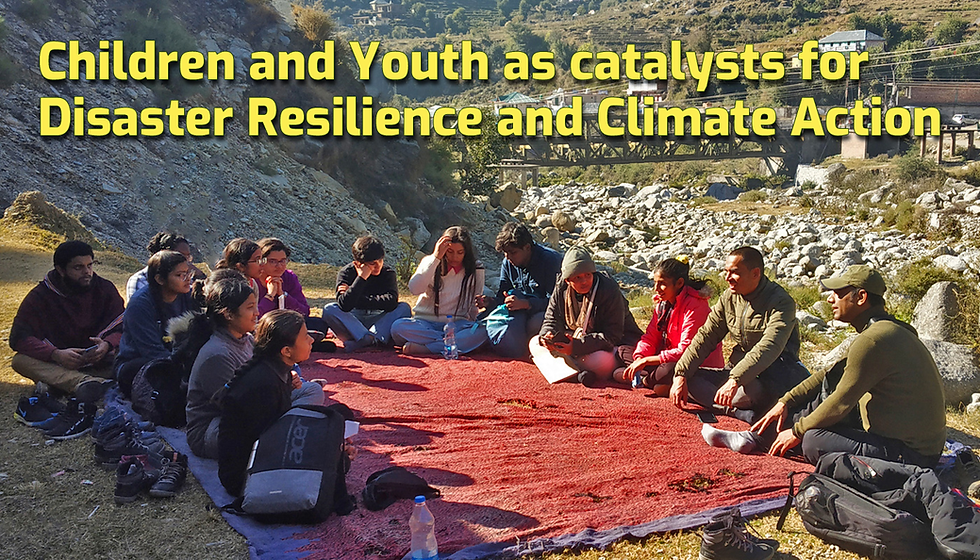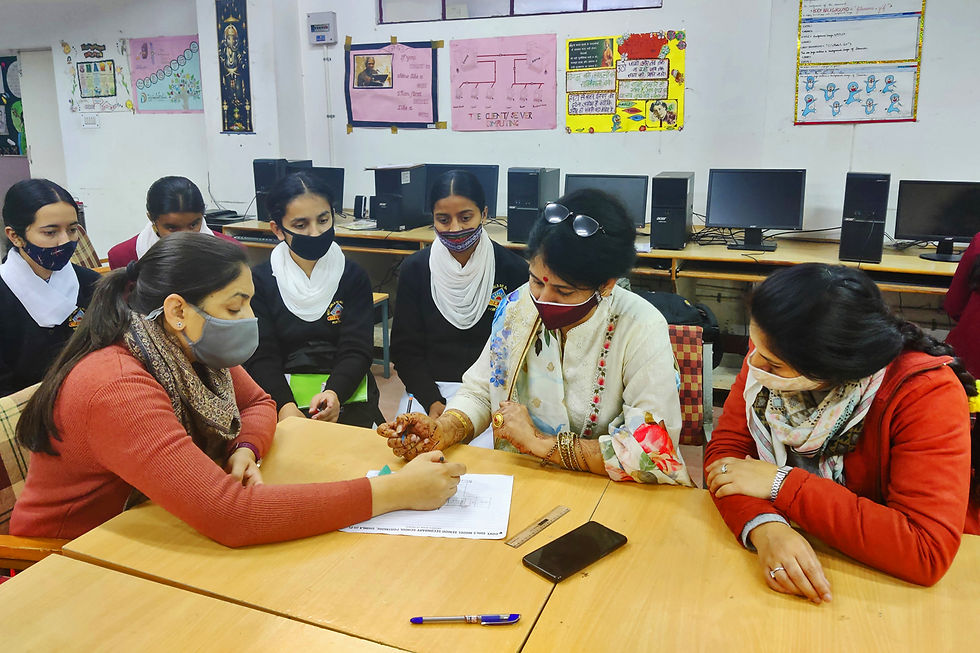Engaging Children & Youth in Disaster Resilience and Climate Action
- doersngo
- May 8, 2024
- 5 min read
Updated: May 9, 2024

Doers is a humanitarian organization dedicated to building resilient and climate-smart communities in the Himalayan region of India. It was founded in 2015 in the state of Himachal Pradesh by a group of like-minded youth who were driven to act by the Nepal Earthquake of 2015. For nearly nine years, Doers has been engaged within the realms of disaster risk reduction, climate change adaptation, and humanitarian response. With a systems approach at its core, Doers’ interventions revolve around the themes of Resilience, Sustainability, and Empowerment. In the pursuit of generating a culture of preparedness and resilience against climate-induced hazards, we consistently engage with a range of stakeholders, including the government, academia, civil society organizations, communities (rural and urban), and the children and youth, in Himachal Pradesh.
Children and youth not only stand to benefit tremendously from a resilient and sustainable future but are also one of its key architects. Their curious dispositions and ability to engage with peers and adapt to dynamic situations give them a natural advantage as drivers of change. At the same time, when disasters occur, their age, psychosocial development, and relative inexperience also make them the most vulnerable group. With our shared future threatened by a rapidly changing climate, its resultant hazards, and a lack of preparedness against them, engaging children and youth in DRR-focused interventions becomes a moral imperative. Given below are some of our initiatives focused on the involvement of children and youth in the processes related to disaster resilience and climate action.
1. STEP Workshops for Schools and Colleges

The ‘Safety Through Emergency Preparedness (STEP)’ initiative by Doers is designed to upskill children and youth to deal with disasters and emergency situations not only within schools and colleges, but also beyond. Through #STEP2Resilience workshops, Doers develops essential skills including First Aid, CPR, Fire Safety, basic Search & Rescue, general emergency preparedness and disaster risk mitigation among children and youth to minimize loss of lives as well as damage to property. These workshops are highly appreciated by participating children and youth who, once trained, become active agents of change in their family, school/college, neighborhood as well as the community and continue to advocate for disaster preparedness. The best part of #STEP2Resilience workshops is that the students get practical experience by engaging in hands-on learning activities.
2. Equipping Youth with ICT tools for Disaster Risk Management

As an organization endeavoring to address systemic risks by strengthening the data ecosystem as well as decision support with ICT-enabled solutions, Doers has been engaging with the youth in harnessing the power of ICT tools and resources for effective disaster risk management. Through our youth-centric capacity development interventions focusing on #ICT4DRM, we are equipping youth with resources, open-source tools and mobile applications that are immensely useful in different phases of disaster risk management. We train youth in using KoboToolBox for disaggregated data collection; utilizing easy-to-use tools such as Google Earth and Google My Maps for disaster-related mapping; capitalizing on the power of social media for effective risk communication (through effective communication materials in local languages and using relevant hashtags); accessing critical information in post-disaster settings by using resources such as Google Person Finder and Facebook Crisis Response; staying informed, aware, ready and alert about disasters with the help of mobile apps such as Sachet (by the Government of India), First Aid (by the IFRC), eRaktkosh (by National Health Mission, GoI), Mausam (by the India Meteorological Department); and obtaining and sharing GPS locations without Internet by using apps like GPS Coordinates.
3. Engaging Youth in Micro-mapping of Critical Facilities, Resources & Infrastructure

The mainstay of micro-mapping is generating highly tactical digital maps that incorporate in-depth information on critical facilities, resources and infrastructure sourced at the local level. Developed through a process which leaves minimum room for error, these digital maps have highly customizable attributes and can be viewed both online and offline. Maps produced through the micro-mapping process enable effective planning for disaster preparedness and mitigation, efficient decision-making during disaster response, and the creation of realistic scenarios for disaster-related mock drills. Doers imparts this critical skill, which falls under the larger umbrella of #ICT4DRM, to students and youth volunteers through training workshops. Comprising easy-to-learn tools that do not require a paid subscription, these engagements empower the youth to utilize mapping for effective disaster risk mitigation and response. During the micro-mapping exercises conducted in the past, Doers brought together numerous young volunteers who micro-mapped critical facilities, resources and infrastructure (such as such as Fire Hydrants, Groundwater Springs, etc.) in different parts of Himachal Pradesh.
4. 'Connecting the Dots' Bootcamps on Disaster Resilience and Climate Action

Sensitizing the youth at the threshold of their careers and equipping them with the resources to become leaders in the fields of disaster resilience and climate action is at the heart of Doers’ Connecting the Dots Bootcamps. The Bootcamps bring together the latest, contextual knowledge and tools related to disaster risk resilience, risk-informed development, and climate change adaptation to connect motivated, competent youngsters to the right opportunities. They explore the interconnections between the Sustainable Development Goals (SDGs), the Sendai Framework for Disaster Risk Reduction and the Paris Agreement. It is always our endeavor to scratch beneath the surface and unravel the multilayered systemic issues to facilitate a holistic understanding. As such, the Bootcamps deftly combine instruction and play through presentations, demonstrative exercises, and Gamified Learning Activities to help young participants grasp complex ideas easily.
5. Promoting Risk Knowledge and Awareness among Children and Youth

Doers believes that to create disaster-resilient communities, it is important to engage young people in interesting learning processes related to disaster preparedness. Through our active participation in annual events such as ‘Samarth’ organized by the Himachal Pradesh State Disaster Management Authority (HPSDMA) to mark the International Day for Disaster Risk Reduction, we conduct various entertaining, educational and interactive learning activities at our stall. Some of the most engaging activities include — Micro-sessions on themes such as creating a Family Emergency Preparedness Kit and a First Aid Kit; Quiz on Disasters and Preparedness; and fun-filled Gamified Learning Activities related to disaster risk reduction. We also promote awareness about the disasters that have occurred in the past and impacted the region significantly. We also disseminate the key messages around disaster risk reduction among the youth and encourage them to engage in the online discussions related to #NoNaturalDisasters, #StopTheSpiral, #ItsAllAboutGovernance, #ResilienceForAll and #PreventionSavesLives.
6. Training Children and Youth for Emergency Evacuation Planning

Doers engages the children and youth in educational institutions to become active agents of disaster risk reduction and participate in the planning and effective execution of disaster-activities such as hazard-identification, emergency evacuation. We support the institutions such as universities, colleges and schools in their disaster risk management planning processes with an active and sustained involvement of children and youth. Our team trains the young students to develop emergency evacuation plans using scenario-based approach considering various hazards such as earthquake, fire, floods and landslides. As the most important stakeholders in the processes related to disaster risk management processes, these trained children and youth contribute to the activities related to mitigating the non-structural risks in their institutions.
7. Capacity Development of Teachers on Comprehensive School Safety Framework

In order to ensure the proactive participation of children and youth in keeping their schools safe and making disaster risk reduction an integral process of holistic child development and youth empowerment, it is crucial to build the capacities of their teachers on the Comprehensive School Safety Framework. Doers has been training school teachers in Himachal Pradesh and other states of India on the implementation of the Comprehensive School Safety Framework by facilitating action on its three pillars — Safer Learning Facilities, School Safety and Educational Continuity Management, and Risk Reduction and Resilience Education. We have developed training materials for teachers, which we deliver through training programs in partnership with the Himachal Pradesh State Disaster Management Authority (HPSDMA); Himachal Pradesh State Council of Educational Research and Training (HPSCERT), Solan; Government College of Teacher Education (GCTE), Dharamshala; and the District Institute of Education and Training (DIET) of various districts in Himachal Pradesh.
.png)



Comments